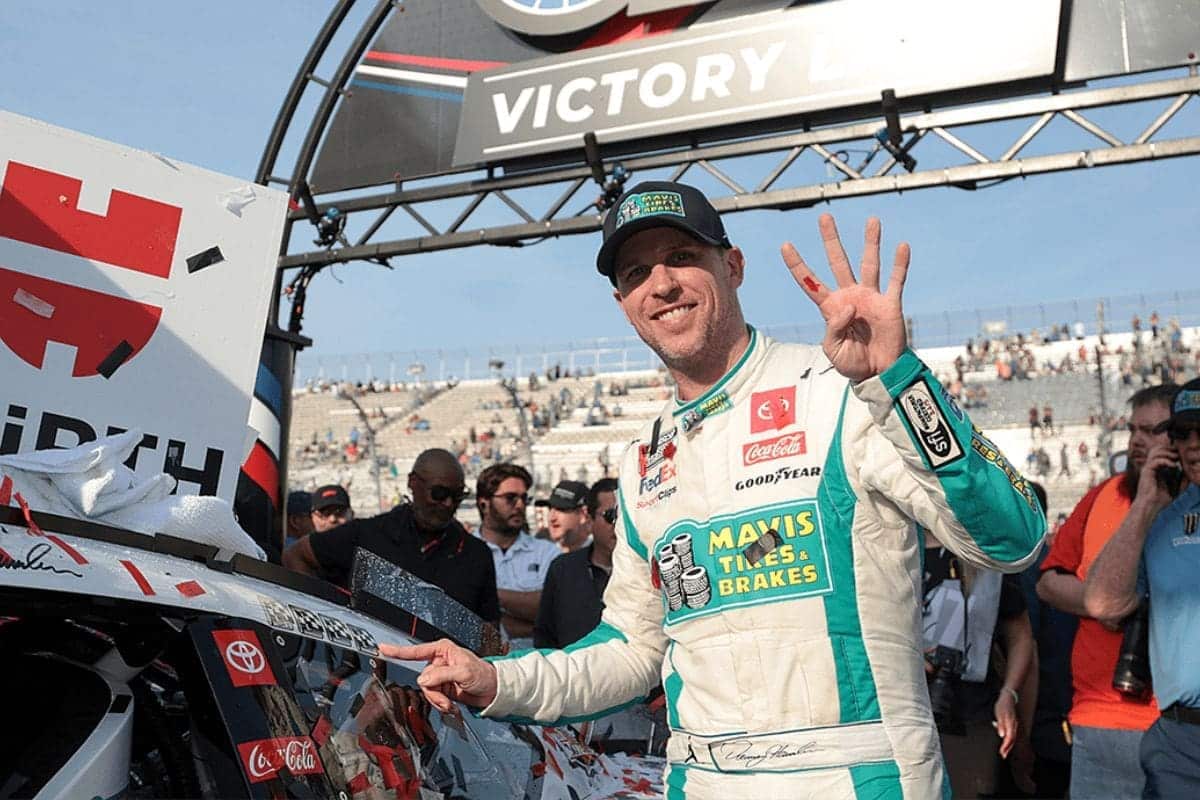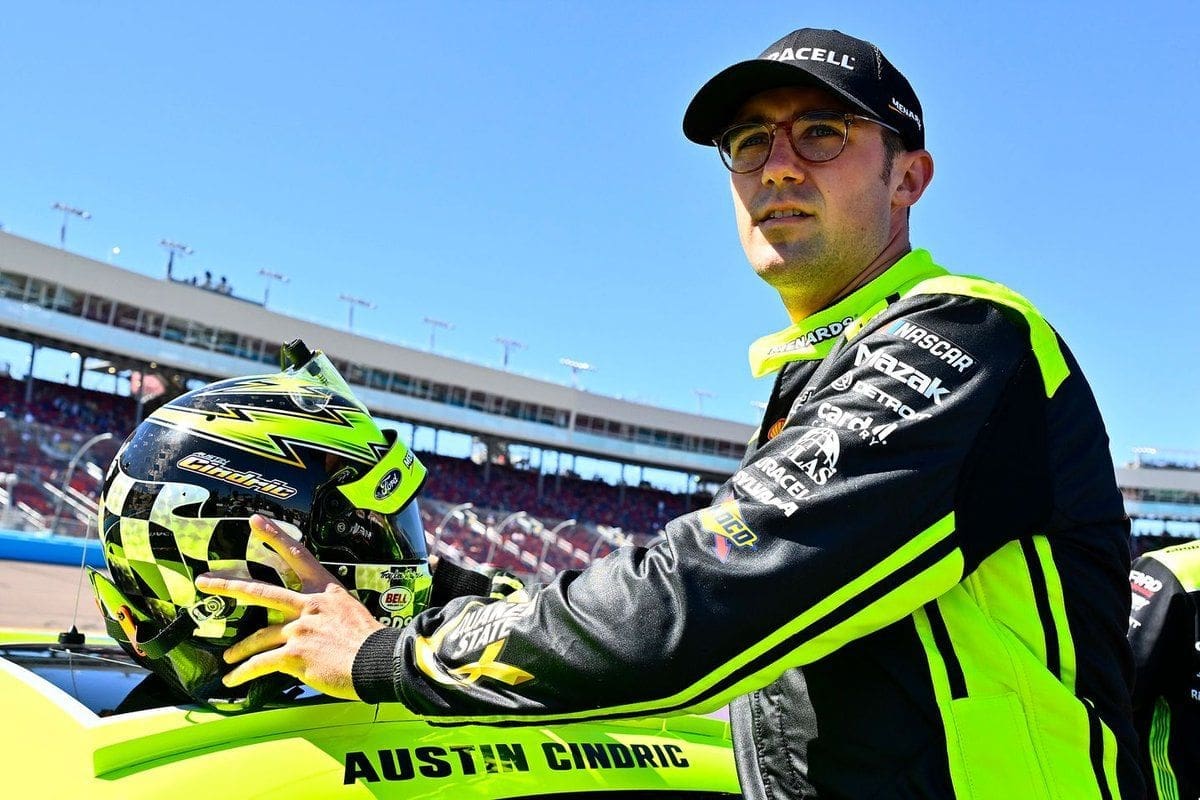Denny Hamlin’s Strategy Fails: In the record-breaking Nashville race, Denny Hamlin‘s strategy crumbled under the weight of challenging weather conditions, fuel constraints, and unforeseen incidents, such as Austin Cindric‘s collision. Despite leveraging his expertise and executing favorable restarts, Hamlin found his plans upended by the chaos of multiple cautions and overtime restarts. High humidity and intermittent rain further compromised traction, leading to numerous crashes that complicated Hamlin’s approach. This race served as a reminder of the delicate balance between preparation and adaptability, and how unpredictable elements can derail even seasoned drivers.
Key Highlights
- Rain delays and high humidity caused traction issues and crashes, disrupting Hamlin’s strategy.
- Fuel limitations hindered Hamlin’s ability to capitalize on favorable restarts.
- Frequent cautions forced unplanned pit stops, complicating Hamlin’s race strategy.
- Austin Cindric’s collision led to overtime restarts, further disrupting Hamlin’s tactical decisions.
- Strategic recalculations became necessary after Christopher Bell’s crash, affecting Hamlin’s race approach.
Race Overview and Challenges
The 2024 Nashville race epitomized the unpredictability of NASCAR, marked by relentless rain delays, a record 16 cautions, and strategic upheavals. The Ally 400 was nothing short of a chaotic symphony, reflecting the tumultuous nature of stock car racing. The race’s commencement was repeatedly postponed due to persistent rain showers, setting a tone of uncertainty that would permeate the entire event.
Central to the drama was Christopher Bell, who dominated the early stages by clinching victories in both the initial stages. Bell’s command, however, was abruptly terminated on lap 228 when he crashed out, triggering a cascade of strategic recalculations among the competing teams. This incident was but a precursor to a carefully series of cautions that extended the race to an arduous 331 laps, far beyond the scheduled 300.
The record-breaking 16 cautions prolonged the race and drastically altered the pit strategies of numerous teams. The extended duration necessitated unplanned pit stops, leading to a reshuffling of the field and rendering pre-race strategies obsolete. Cars that had been leading found themselves thrust into the middle of the pack or worse, caught up in subsequent wrecks.
The usual race leaders, who had carefully planned their pit stops and fuel management, saw their efforts unravel in the face of the relentless unpredictability. This chaotic environment fostered an atmosphere where adaptability was paramount, challenging even the most seasoned drivers and crew chiefs to their limits.
Denny Hamlin’s Perspective
Denny Hamlin’s viewpoint on the race emphasizes the detailed balance between skill and luck in the presence of unpredictable elements. The Nashville Superspeedway presented a challenging obstacle, where the combination of high humidity, rain, and thunderstorms played a crucial role in reshaping the race dynamics. Hamlin’s reflections highlight the significant impact of weather conditions on race strategy and outcomes.
Hamlin was keenly aware of the advantages and disadvantages influenced by Mother Nature. The rain, which delayed the race after 137 laps, washed off the traction that had built up, creating a dangerous track. This unforeseen change led to numerous cars losing control, either crashing into the wall or sliding into the grass. For Hamlin, these conditions turned the race into a test of not just driving skills but also strategic insight.
Despite securing favorable restarts, Hamlin’s strategy was hindered by fuel limitations. His remark, ‘I got the restarts I wanted each time but just didn’t have enough fuel in the tank,’ captures the essence of his frustration. He was dangerously close to victory—15 seconds away at one point—only to see his chances fade away due to the successive effects of cautions and spins.
“I got the restarts I wanted each time but just didn’t have enough fuel in the tank. So you know, a bunch of us in that same boat. I was 15 seconds away from a win…when Austin Cindric spun and then 10 seconds away, a few cautions after that. So it’s just, I don’t know, unlucky.” – Hamlin
Denny Hamlin stretched the fuel as long as he could. How he summed up his Nashville: pic.twitter.com/WBlrpoohDb
— Bob Pockrass (@bobpockrass) July 1, 2024
Austin Cindric Incident and Hamlin’s Prediction
Amidst the chaotic weather conditions and strategic challenges faced by Denny Hamlin, Austin Cindric’s late-race collision with Noah Gragson initiated a sequence of overtime restarts that further complicated the race dynamics. With two laps remaining, this incident set off a chain reaction of multiple restarts, leading to an unpredictable and tumultuous endgame that severely disrupted race strategies.
Denny Hamlin, who had been engaged in a fierce battle with Ross Chastain and Kyle Larson, foresaw the ensuing chaos. ‘I knew once they started one, it was gonna be lots of them,’ Hamlin commented, reflecting on the aggressive maneuvers and the inevitable contact in turn 1. His prediction highlighted the volatile nature of overtime restarts, where every driver’s desperation for victory often leads to a series of incidents and cautions.
I knew once they started one, it was gonna be lots of them…just the way that everyone’s going into turn 1 and everyone sliding, and beating and banging. I knew that we were cooked. I thought we were cooked after the first of them.” – Hamlin
This development profoundly impacted pit strategies. Running low on fuel, Hamlin and his counterparts faced a dilemma: pitting would eliminate their chances of winning, yet staying out risked running dry. Hamlin chose to gamble, staying on track until his fuel tank was nearly empty. ‘We ran as long as we did,’ Hamlin explained.
“We ran as long as we did. I was assembling when we came into the box…We were fine with running it out. We had pit other times before…the given situation was fine, like (we had to) run the tank out and we did.” – Hamlin
Despite previous pit stops, the extended series of overtime restarts tested the limits of fuel strategies. Hamlin’s decision to ride it out until the end, though ultimately unsuccessful, exemplified the thin margins and split-second decisions that define racing.
Joey Logano’s Victory
Joey Logano’s win at the record-breaking Nashville race displayed his strategic expertise and ability to persevere through fuel management challenges. As the race neared its climax, Logano found himself in a delicate position with a dwindling fuel supply. His ability to stretch his fuel tank to the limit while maintaining a competitive pace exemplifies his tactical prowess. Despite the threat of an empty tank, Logano managed to cross the finish line.
The victory was not handed to Logano on a silver platter. The race’s multiple restarts and fluctuating dynamics demanded constant adaptation. When Denny Hamlin’s strategy faltered on the subsequent restart, it created an opening for Logano. However, the path to victory was anything but straightforward. Hamlin’s teammate, Tyler Reddick, emerged as a formidable challenger, charging through the ranks to pose a significant challenge. This unexpected twist forced Logano to dig deep into his reserves of skill and tenacity.
Logano’s ability to fend off Reddick, while simultaneously managing his fuel levels, highlights his dual focus on strategic depth and reactive agility. His victory was a masterclass in balancing risk and reward, showcasing the importance of precise decision-making under stress. With the Cup heavyweights momentarily out of the picture, Logano seized the opportunity, demonstrating why he remains a force to be reckoned with in NASCAR.
Tyler Reddick’s Effort and Outcome
While Logano celebrated his victory, Tyler Reddick’s valiant effort and near-miss highlighted the intense competition and heartbreak inherent in the race. Reddick, the sole driver among the eleven contenders in the fifth overtime restart to have already secured a win this season, was poised to capitalize on Logano’s precarious fuel situation. His dedication to secure another win was apparent as he skillfully guided his car, staying in the race till the very end. However, despite his persistent pursuit, Reddick fell short, finishing third behind Zane Smith, as Logano managed to cross the finish line despite his fuel concerns.
Reddick’s post-race comments laid bare his frustration and disappointment. ‘All the good cars ran out of fuel, and we were in position to pass (Logano). He hadn’t been good all day long, and I didn’t get the job done,’ he lamented. His third-place finish, while commendable, was a tough pill to swallow, especially given the high-pressure situation and the effort he invested.
“All the good cars ran out of fuel, and we were in position to pass (Logano). He hadn’t been good all day long, and I didn’t get the job done.”
“I’m trying my best, but it’s tough. I’m trying to keep it cool at the moment. I’m really upset about how that ended.” – Reddick
The emotional weight of Reddick’s remarks, ‘I’m trying my best, but it’s tough. I’m trying to keep it cool at the moment. I’m really upset about how that ended,’ highlights the unrelenting tension and emotional toll faced by drivers. Nevertheless, as a 23XI Racing driver, Reddick remains a formidable competitor poised to shine in upcoming races. His resilience and skill will surely propel him forward, offering numerous opportunities for redemption and victory in the future.
News in Brief: Denny Hamlin’s Strategy Fails
The Nashville race highlighted the complexities of motorsport strategy, where even experienced drivers like Denny Hamlin can falter due to uncontrollable variables.
Hamlin’s challenges, worsened by adverse weather, fuel constraints, and incidents like Austin Cindric’s collision, emphasized the unpredictability of racing.
Despite strategic restarts, the race’s chaotic nature disrupted plans and emphasized the delicate balance between thorough preparation and flexibility needed to navigate the unexpected challenges that characterize competitive racing.
ALSO READ: JGR Veteran Uncovers Denny Hamlin’s True Colors Amid ‘Hypocrisy’ Outrage



